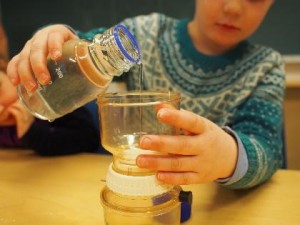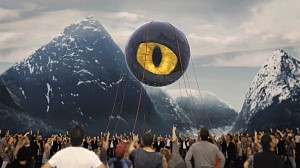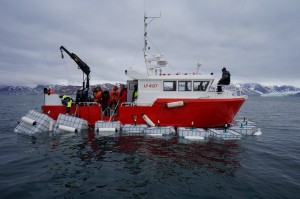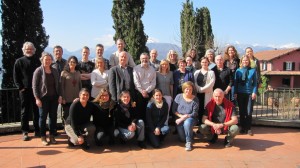February 2017 CarbonBridge contributes to childrens activities on living sea ice
CarbonBridge scientists, Lena Seuthe, contributed to a children’s museum event as part of the exhibition “Living sea ice” at the Polar museum in Tromsø. Nearly 60 kids and their parents conducted simple hands-on experiments on the structure and formation of sea ice, as well as sea ice as habitat for various plants and animals. Play doh and other materials were used by the children to sculpture plants and animals found in Arctic sea ice.
____________________________________________________________________
January 2017 CarbonBridge hosts session at Arctic Frontiers Conference
 CarbonBridge hosted one of the scientific sessions at this years’s Arctic Frontiers Conference in Tromsø, under the lead of CarbonBridge PI Marit Reigstad. The session featured both oral presentations and posters under the topic of ‘Bridging physical and biological processes in the Arctic Ocean’.
CarbonBridge hosted one of the scientific sessions at this years’s Arctic Frontiers Conference in Tromsø, under the lead of CarbonBridge PI Marit Reigstad. The session featured both oral presentations and posters under the topic of ‘Bridging physical and biological processes in the Arctic Ocean’.
CarbonBridge scientists contributed heavily to the conference with eight oral presentations and numerous posters. In addition, CarbonBridge scientists contributed to the conference’s outreach component by joining the conference’s Pech Kucha night in town.
_____________________________________________________________________
January 2017 CarbonBrigde contributes to exhibition on “living sea ice”
 The Polar museum in Tromsø opened a new exhibition on Arctic sea ice as living environment for plants and animals. CarbonBridge PIs, Marit Reigstad and Paul Wassmann, heavily contributed to the context and format of the exhibition.
The Polar museum in Tromsø opened a new exhibition on Arctic sea ice as living environment for plants and animals. CarbonBridge PIs, Marit Reigstad and Paul Wassmann, heavily contributed to the context and format of the exhibition.
_____________________________________________________________________
December 2016 CarbonBridge visits elementary School
 Do you know how many plants and animals you swallow each time you get some drops of seawater into your mouth while swimming in the sea?, asked CarbonBridge scientist, Lena Seuthe, the first grade at Sandenessund elementary school in Tromsø.
Do you know how many plants and animals you swallow each time you get some drops of seawater into your mouth while swimming in the sea?, asked CarbonBridge scientist, Lena Seuthe, the first grade at Sandenessund elementary school in Tromsø.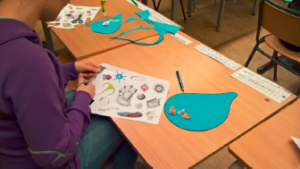
With help of mircoscopes, the kids discovered tiny living plants and animals in drops of water, observing their different svimming and feeding behaviour.
During the following art class, the pupils drew, coloured and clipped their own plants and animals living in drops of seawater.
___________________________________________________________
December 2016 CarbonBridge back at Tromsø’s childrens university
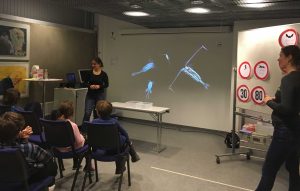 Nine month after its first contribution, CarbonBridge was back at Tromsø’s childrens university. This time, CarbonBridge scientist Elisabeth Halvorsen and Lena Seuthe, talked about the World’s fatest animals, which are in contrast to common belief not cheetahs or peregrines, but small crustaceans (copepods) living in the sea. These crustaceans are highly abundant in the World’s Ocean, where they play a key role in transferring energy from plants up to higher trophic levels, such as fish. Given their importance, these crustanceans were extensively studied within the CarbonBridge project in the waters north and northwest of Svalbard.
Nine month after its first contribution, CarbonBridge was back at Tromsø’s childrens university. This time, CarbonBridge scientist Elisabeth Halvorsen and Lena Seuthe, talked about the World’s fatest animals, which are in contrast to common belief not cheetahs or peregrines, but small crustaceans (copepods) living in the sea. These crustaceans are highly abundant in the World’s Ocean, where they play a key role in transferring energy from plants up to higher trophic levels, such as fish. Given their importance, these crustanceans were extensively studied within the CarbonBridge project in the waters north and northwest of Svalbard.
Tromsø children’s university is a cooperation between the UiT- The Arctic University of Norway and the central library in town, aiming at conveying research at UiT in an easy and fun manner to kids of 7 to 12 years of age.
___________________________________________________________
November 2016 CarbonBridge scientist receives research award
 CarbonBridge PhD student, Achim Randelhoff, received this year’s Fram Center award for best research. The jury emphasized that Randelhoff has worked highly interdisciplinary and by that filled essential knowledge gaps in our understanding of Arctic marine productivity.
CarbonBridge PhD student, Achim Randelhoff, received this year’s Fram Center award for best research. The jury emphasized that Randelhoff has worked highly interdisciplinary and by that filled essential knowledge gaps in our understanding of Arctic marine productivity.
Randelhoff works on the turbulent mixing and vertical nitrate fluxes in ice-covered Arctic waters, and has contributed with new understanding to mechanisms confining primary production in highly stratified waters. ___________________________________________________________
October 2016 CarbonBridge team wines price for its outreach
The CarbonBridge team contributed to this year’s research days with a stand at the science fair of UiT-The Arctic University of Norway, and won the price for best science fair stand 2016.
 Joining in on the general theme, “Boarders”, of this year’s research days, CarbonBridge designed a suite of easy experiments on the visible and invisible boarders found in the Arctic Ocean. The ice edge was chosen as a very visible Arctic boarder, discussing its dynamics and retreat. Special focus was given to the impact of melting sea ice on the formation of invisible boarders between fresher ice melt water over saline seawater. Visitors could test this effect in an easy hand on experiment with seawater and colored ice cubes. The impact of such water column stratification on algae growth in the sea was discussed, and algae shown to the visitors through a microscope.
Joining in on the general theme, “Boarders”, of this year’s research days, CarbonBridge designed a suite of easy experiments on the visible and invisible boarders found in the Arctic Ocean. The ice edge was chosen as a very visible Arctic boarder, discussing its dynamics and retreat. Special focus was given to the impact of melting sea ice on the formation of invisible boarders between fresher ice melt water over saline seawater. Visitors could test this effect in an easy hand on experiment with seawater and colored ice cubes. The impact of such water column stratification on algae growth in the sea was discussed, and algae shown to the visitors through a microscope.
As CarbonBridge is concerned with the impact of warm Atlantic water on stratification and algae production in the Arctic, the stand also embraced an experiment on the potential of warm water to deteriorate water column stratification.
The stand was well received by hundreds of visitors from 3 to 60+ years of age, offering experiments and explanations at various knowledge levels, which was emphasized as especially positive by the price jury.
___________________________________________________________
September 2016 CarbonBridge PhD course on The story and impact of Arctic marine science
Arctic marine science is not only about the natural sciences, even though that is what we work with on a daily basis. However, the increased societal interest and focus on the Arctic increasingly challenges natural scientists with demands on Arctic related questions that reach far beyond their field of natural science. Therefore, CarbonBridge gathered experts from various academic fields for a PhD workshop to address and discussion questions, such as In which tradition do we conduct our science in the Arctic? Are we part of an Arctic heroic story told to the public? Which role do we as natural scientists have in society? Is the research free from political influence and industrial interests?
 The PhD course gathered 6 students from different fields of natural science and resource economics, 8 lecturers, and interested guests who followed presentations and participated discussion on issues covering four main themes including a) Historical perspectives, b) The Arctic image, c) Science communication and d) Is science politically independent?
The PhD course gathered 6 students from different fields of natural science and resource economics, 8 lecturers, and interested guests who followed presentations and participated discussion on issues covering four main themes including a) Historical perspectives, b) The Arctic image, c) Science communication and d) Is science politically independent?
The lecturers included in marine biology Prof. Paul Wassmann (UiT), in marine microbiology Prof. Frede Thingstad (UiB), in literature Prof. Johan Schimanski (UiO), in marine resource management Prof. Petter Holm (UiT), in fisheries management Prof. Bjørn Hersoug (UiT), in geology and writing Prof. Henrik Svensen (UiO),as well as director at the Polar Museum, Lena Aarekol (UiT), and senior scientist in environmental philosophy and ethics, Fern Wickson (Genøk).
The students elaborated on the themes through writing of a reflection text, presentation of posters with feedback from the group, participation in discussions and finally through production of a blog text on a science topic of their own choice.
___________________________________________________________
September 2016 Discussion round on the biology and politics of Arctic sea ice
 Interesting new perspectives arise when different scientific fields meet to explore the sea ice. As part of the UiT seminar series, UiT breakfast, CarbonBridge PI Marit Reigstad, (professor in biology, UiT) and Phil Steinberg (professor in political geography, Durham University) was invited with moderator Berit Kristoffersen (researcher in political geography) to discuss how sea impacted the biology and politics of the Arctic on Wedensday 21 September at Verdensteateret, Tromsø.
Interesting new perspectives arise when different scientific fields meet to explore the sea ice. As part of the UiT seminar series, UiT breakfast, CarbonBridge PI Marit Reigstad, (professor in biology, UiT) and Phil Steinberg (professor in political geography, Durham University) was invited with moderator Berit Kristoffersen (researcher in political geography) to discuss how sea impacted the biology and politics of the Arctic on Wedensday 21 September at Verdensteateret, Tromsø.
__________________________________________________________________
September 2016 CarbonBridge co-leader meets Italians ambassador
CarbonBridge co-leader, Prof. Paul Wassmann, met Italians ambassador, Giorgio Novello, at UiT on September 9, as part of the Italian Embassy’s roadshow through Norway. The roadshow “Under the Sign of Excellence” focuses on the cooperation between Italy and Norway, and Paul Wassmann gave a seminar on the «Two mediterranean seas: contrasts and similarities», which was well received by Novello.
__________________________________________________________________
August 2016 Teach marine biology in pre-School
 CarbonBridge scientists, Lena Seuthe, was invited to talk to 30 pre-school students at UiT (as part of BLU-1207) about how to in cooperate more marine biology into everyday activities in pre-schools. The five-hour long class was conducted in and outside a boat shed on the southern tip of Tromsøya, and included hands-on activities with marine organisms found and caught by the students.
CarbonBridge scientists, Lena Seuthe, was invited to talk to 30 pre-school students at UiT (as part of BLU-1207) about how to in cooperate more marine biology into everyday activities in pre-schools. The five-hour long class was conducted in and outside a boat shed on the southern tip of Tromsøya, and included hands-on activities with marine organisms found and caught by the students.
__________________________________________________________________
June 2016 CarbonBridge meets Dark Ecology and Arctic Encounters
How does the sea ice come to matter? That was the question for a debate on Verdensteateret in Tromsø, where art-, social science- and natural science perspectives met to explore the ice edge. Or isn’t it rather a seasonal sea ice zone that matters? Sea ice has become a strong symbol of Arctic responses to climate change and is has also become an important tool for governments in regulating or allowing activities in the north.
The discussion revealed the facet of perspectives on sea ice when CarbonBridge PI, Marit Reigstad and colleague Prof. Bodil Bluhm shared thoughts and experience from ice-covered waters with post doc in political science and political geography Berit Kristoffersen (UiT and Arctic Encounters), curator Hilde Methi (independent curator, and Dark Ecology, Kirkenes), and artist Jana Winderen (exploring hidden depths and sources and like water and ice through sounds, Dark Ecology), just back from a UiT cruise to the Barents Sea.
The arrangement was organized by the two projects Arctic Encounters and Dark Ecology, exploring how objects, landscapes and seascapes in the Arctic matter ethically, politically & aesthetically. The arrangement featured key thinkers, curators, artists, artwork and short films to create dialogue about the Anthropocene, the ice-edge, indigeneity and much more.
__________________________________________________________________
April 2016. Stakeholders interrested in CarbonBridge’s primary production estimates
To understand the impact of climate change on sustainable fishproduction, the response at the basis of the food web, namely primary production, is a key.
CarbonBridge was therefor happy to provide input from our project work to a presentation held by Prof. Michaela Aschan on Kystens hus, April 27. The presentation was a part of a seminar series where the science community presents relevant research to users living from or with the sea.
CarbonBridge is glad to note that through our different appraoches to address productivity and fate of production in the Arctic, seem to produce information that is of great interest to users and stakeholders
__________________________________________________________________
April 2016. CarbonBridge’s preschool science project on local radio and TV
CarbonBridge’s preschool science project has lately received attention on Norwegian broadcasting, both on radio and television.
The project is progressing well, with the kids filtering seawater weekly. Last week’s sampling showed the first clear signs of spring in the sea. The kids not only observed some greenish color on the filter, but also observed long diatom chains under the microscope. On land, the snow still covers much of the ground. So, the kids start to suspect that spring might come earlier in the sea than on land.
_______________________________________________________________
March 2016. CarbonBridge starts preschool science project
Do you know where it gets spring first: in the sea or on land?
CarbonBridge posed that question to five-year-old preschool kids from Tusseladden friluftsbarnehagen in Tromsø this week. About half of the kids meeting CarbonBridge scientist, Lena Seuthe at UiT – The Arctic University of Norway, were convinced that it is the grass and trees on land which will turn green before small algae start growing in the sea.
The children will find out whether they are right or wrong by filtering seawater and evaluating the color of the particles retained on the filter. As the spring bloom of small algae in the sea progresses, the filter should turn greener. The kids will take pictures of the filters as well as the trees and ground on land. From these pictures, the kids will build a time line of the spring progression on land and in the sea, and find a final answer to where it greens first.
 CarbonBridge leader, Marit Reigstad, presented CarbonBridge’s approaches and results of studying primary production in the Atlantic Water inflow region to the Arctic Ocean during the SI_Arctic annual meeting 17 February. This include in-situ measurements, comparison of different ways of measuring primary production and a discussion of what information they provide, model experiments used to address the advective patterns of primary production and export to the Arctic Ocean, as well as large scale modelling of primary production.
CarbonBridge leader, Marit Reigstad, presented CarbonBridge’s approaches and results of studying primary production in the Atlantic Water inflow region to the Arctic Ocean during the SI_Arctic annual meeting 17 February. This include in-situ measurements, comparison of different ways of measuring primary production and a discussion of what information they provide, model experiments used to address the advective patterns of primary production and export to the Arctic Ocean, as well as large scale modelling of primary production.______________________________________________________________
February 2016. CarbonBridge at Tromsø children’s university
 Tromsø children’s university is a cooperation between the UiT- The Arctic University of Norway and the central library in town, aiming at conveying research at UiT in an easy and fun manner to kids of 7 to 12 years of age. CarbonBridge scientist, Lena Seuthe, took the challenge and talked about ocean currents and the impact of Atlantic water on the Arctic. Fourteen eager kids joined the session, and explored experimentally what drives ocean currents and what happens when warm currents hit Arctic sea ice.
Tromsø children’s university is a cooperation between the UiT- The Arctic University of Norway and the central library in town, aiming at conveying research at UiT in an easy and fun manner to kids of 7 to 12 years of age. CarbonBridge scientist, Lena Seuthe, took the challenge and talked about ocean currents and the impact of Atlantic water on the Arctic. Fourteen eager kids joined the session, and explored experimentally what drives ocean currents and what happens when warm currents hit Arctic sea ice.
______________________________________________________________
February 2016. CarbonBridge scientists meet on Sommarøy
CarbonBridge scientists from Europe and North America met on Sommarøy outside Tromsø to discuss the project’s progress. A wealth of data from the field and modelling work are now ready for publishing. The meeting demonstrated that there is good fruitful collaboration between field biologists and modelers within the project, which allows field data to be scaled up in space and time. At the same time, the modelers within the project take advantage of the field data by not only for comparison with model outputs but also for improvement for existing models. Special emphasis is given to the improvement of the models microbial component and the model’s copepod stage development.
______________________________________________________________
December 2015. CarbonBridge scientist developes children’s TV series
CarbonBridge scientist, Lena Seuthe, together with three other scientists from different institutions received funding from the Norwegian Research Council to develop and produce a children’s TV series about marine science. The aim of the series is to convey the challenge, but also the fascination and beauty of marine science to young children in the age of 4 to 9 years.
______________________________________________________________
November 2015. CarbonBridge scientists on Norwegian Television
The week before the climate meeting in Paris, Norwegian television broadcasted a popular science program on the role of marine microbes in the World’s carbon cycle, as part of the renowned science program “Schrödingers katt”. The program “The invisible helpers” was filmed during a microcosm experiment by CarbonBridge’s sister project “MicroPolar” in Ny Ålesund/Svalbard. CarbonBridge scientists, Camilla Svensen and Lena Seuthe, contributed to the television program by commenting on the importance of small crustaceans as top-predators in planktonic communities.
______________________________________________________________
November 2015. CarbonBridge scientists in charge of session at Transatlatic Science Week 2015, Boston
Under the leadership of Paul Wassmann (UiT) and Patricia Matrai (USA), Jørgen Berge (UiT) , Maria Fossheim (IMR), Mar Fernandez Mendes (NPI), Martin Fortier (ArcticNet, Canada) and Carin Ashjian (USA) presented talks at 1. Stewardship of the Sea, 1.2 Life and Ecosystems. All talks were directed to the dynamic of the seasonal ice sone of the Arctic Ocean. All underlined the necessity of a closer cooperation and coordination of international research in the Arctic Ocean.
______________________________________________________________
November 2015. CarbonBridge co-leader becomes member of the European Academy of Sciences (EURASC)
CarbonBridge co-leader, Paul Wassmann, was elected member to the European Academy of Sciences (EURASC). EURASC is a non-profit non-governmental, independent organization of the most distinguished scholars and engineers performing forefront research and the development of advanced technologies, united by a commitment to promoting science and technology and their essential roles in fostering social and economic development.
Committee member, Professor Paul Tréguer from Université de Bretagne Occidentale, France, said about Paul Wassmann:
“Paul Wassmann was one of the major leaders of the EUR-OCEANS Network of Excellence (2005-2008) dealing with the impacts of global change on the marine ecosystems. Within the framework of EUR-OCEANS Paul Wassmann led the studies of the impacts of climate change on the Arctic ocean ecosystems and his relevant contribution to reach the objectives of the European Network of Excellence was very much appreciated. The election of Paul Wassman at the European Academy of Sciences is a recognition of his leading role in Arctic studies at the international level since decades. It is also a recognition of his excellent work at the head of the ARCTOS PhD school and at the head of the Nansen’s Legacy project.”
______________________________________________________________
October 2015. A wealth of data – CarbonBridge’s sister project “MicroPolar” meets in Banyuls-sur-mer
CarbonBridge’s sister project “MicroPolar” presented it’s data during a three day long meeting in Banyuls-sur-mer, France. CarbonBridge and MicroPolar joined their field work, and collected complimentary datasets. While CarbonBridge focused on the quantification of planktonic biomasses, production and loss rates, MicroPolar focused on genomic descriptions of the investigated plankton communities. Hence, the two projects together have achieved an extraordinary detailed description of the planktonic communities of the Atlantic-fed Arctic Ocean.
______________________________________________________________
September 2015. CarbonBridge leaders won top-status competition at UiT
 The CarbonBridge leaders Marit Reigstad and Paul Wassmann comprise half of the group that recently was given status as best world leading potential at UiT. Wassmann led the proposal on marginal ice zone ecology that was evaluated as outstanding by an international evaluation panel. Together with the UiT professors Bodil Bluhm and Jørgen Berge, they receive a total of >20 mill NOK over four years, including recruitment positions and a new senior position that will be held by the internationally highly merited sea-ice biology researcher, Professor Rolf Gradinger. This will strengthen the entire arctic marine ecology research group at UiT, and opens for new and exploring research topics that also is closely linked to CarbonBridge. A seminar at UiT, 17 November 2015, will initiate the project, with presentations by Prof. Gradinger and Dr. Eddy Carmack.
The CarbonBridge leaders Marit Reigstad and Paul Wassmann comprise half of the group that recently was given status as best world leading potential at UiT. Wassmann led the proposal on marginal ice zone ecology that was evaluated as outstanding by an international evaluation panel. Together with the UiT professors Bodil Bluhm and Jørgen Berge, they receive a total of >20 mill NOK over four years, including recruitment positions and a new senior position that will be held by the internationally highly merited sea-ice biology researcher, Professor Rolf Gradinger. This will strengthen the entire arctic marine ecology research group at UiT, and opens for new and exploring research topics that also is closely linked to CarbonBridge. A seminar at UiT, 17 November 2015, will initiate the project, with presentations by Prof. Gradinger and Dr. Eddy Carmack.
______________________________________________________________
August 2015. CarbonBridge data published in Nature
Experimental data obtained during CarbonBridge and other projects have been published in the high ranking science journal “Nature Climate Change”. The authors tested the expectation that CO2-enhanced gross primary production (GPP) may be temperature dependent in the Arctic. The results confirmed that CO2 enhances GPP (by a factor of up to ten) over a range of 145–2,099 μatm; however, the greatest effects were observed only at lower temperatures and were constrained by nutrient and light availability to the spring period. The temperature dependence of CO2-enhanced primary production could have significant implications for metabolic balance in a warmer, CO2-enriched Arctic Ocean in the future. The work suggests that a twofold increase in primary production during the spring is likely in the Arctic in the future.
Watch: https://www.youtube.com/watch?v=kwoyVMxk290&feature=youtu.be
______________________________________________________________
July 2015. Thanks MicroPolar!
CarbonBridge wants to thank our fantastic “sister-project” MicroPolar for the organization of a successful mesocosm experiment in Ny Ålesund. We are very much looking forward to continue working together with you.
_____________________________________________________________________
July 2015. 12 minutes with Ban Ki-moon and Børge Brende
Secretary-General of the United Nations, Ban Ki-moon, visited Ny Ålesund in advance of the United Nations Climate Change Conference in Paris later this year. Together with the Norwegian Minister of Foreign Affairs, Børge Brende, Ban Ki-moon visited the laboratory facilities used by MicroPolar and CarbonBridge in conjunction with their experimental work in Ny Ålesund. During 12 minutes, Ban Ki-moon was introduced to the world of microbes. The Secretary-General showed special interest in the copepods shown to him.
______________________________________________________________
July 2015. CarbonBridge scientists in front of TV camera
Ingvill Warholm from Warholm Film and Kriss Rokkan Iversen from SALT are joining the mesocosm experiment in Ny Ålesund, producing a documentary about marine microbes for the Norwegian TV channel NRK. As experts in front of the camera are scientists from MicroPolar and CarbonBridge explaining the structure and function of marine microbial communities and their importance to the World’s carbon cycle.
______________________________________________________________
June 2015. CarbonBridge contributes to MicroPolar’s mesocosm experiment
How does the competition for nutrients between phytoplankton and bacteria will change in a future Arctic Ocean influenced by increasing levels of dissolved organic matter running off from land? How do different concentrations of mesozooplankton influence the structure and function of the microbial food web? These are questions CarbonBridge’s sister project “MicroPolar” is addressing in a large scale mesocosm experiment in Ny Ålesund on Svalbard. In total 25 scientists are joining the campaign. CarbonBridge scientists, Camilla Svensen and Lena Seuthe, are part of the zooplankton team, investing micro- and mesozooplankton grazing, defecation and excretion rates.
______________________________________________________________
June 2015. French Masters thesis including acoustic data collected by CarbonBridge
Lia Siegelman, student at the Université Pierre et Marie Curie (France), worked on the distribution of mesopelagic fauna in the Norwegian Sea for her Masters thesis. Supervised by Benjamin Planque from the Institute of Marine Research in Tromsø, Lia Siegelman analyzed acoustic data from different cruises in the Norwegian Sea and Fram Strait, among those data provided by CarbonBridge. Lia Siegelman was able to show that the biomass of mesopelagic fish is higher than earlier thought in the northern part of North Atlantic and its gateway to the Arctic.
______________________________________________________________
May 2015. CarbonBridge scientist Paul Wassmann on radio
CarbonBridge scientist Prof. Paul Wassmann talked about the effect of sea ice for life in the Arctic Ocean when the Norwegian radio program “EKKO – Abels Tårn” was visiting Tromsø in the beginning of May. Together with Prof. Jørgen Bergen from UiT – The Arctic University of Tromsø, Paul Wassmann explained the importance of sea ice in determining the stratification of the water column, nutrient transport and subsequently marine productivity in the Arctic Ocean.
______________________________________________________________
March 2015. CarbonBridge contributes heavily to Gordon Research Conference
CarbonBridge senior scientist Paul Wassmann was chair of this years’ Gordon Research Conference on polar marine science. In the spirit of CarbonBridge the topic of this years’ GRC was “Polar Shelves and Shelf Break Exchange in Times of Rapid Climate Warming”. On the GRC, CarbonBridge was represented by 13 of its scientists, of which two invited speakers, and eight others contributing to the conference with posters.
______________________________________________________________
March 2015. A wealth of data – CarbonBridge meets in Italy
Half a year after the last CarbonBridge cruise, 22 project participants met in Italy to present and discuss first data from the 2014 field campaigns. Sample analysis are either completed or well on their way, and hence much of the discussion circled around the question how information should be combined and published. CarbonBridge aims at publishing its core work as a special volume in Frontiers in Marine Science latest by the end of 2016.
______________________________________________________________
January 2015. CarbonBridge scientists present first results
During the scientific part of the Arctic Frontiers Conference in Tromsø, Norway CarbonBridge scientists presented first results from the CarbonBridge cruises in 2014.
Paul Wassmann (UiT – The Arctic University of Norway) talked about “The contiguous domains of Arctic Ocean advection: trails of life and Death”, where he demonstrated that the central Arctic Ocean is not isolated, but tightly connected to the northern Pacific and Atlantic Oceans. In his review, Paul Wassmann presented information about the advection and fate of zooplankton in the Arctic Ocean, now and in the future. He characterised the various organism types that interact along the contiguous domains and showed how life derived from subarctic production regimes fuels life in the Arctic Ocean. Paul Wassmann concluded that the Arctic Ocean is, at least in some regions, a net heterotrophic ocean that – during the foreseeable trend towards global warming – will obtain an increased balance between local and advective production and consumption.
Sünnje Basedow (University of Nordland) presented CarbonBridge data on “Advection of Atlantic Water and secondary producers into the Arctic Ocean” together with Arild Sundfjord from the Norwegian Polar Institute. The two CarbonBridge scientists aim to quantify seasonal changes in the inflow of AW and the secondary producers contained therein. For that, data with high spatial resolution were collected along transects across the AW inflow west and north of Svalbard during the three CarbonBridge cruises in winter (January), spring (May) and summer (August) 2014. Water currents were measured along the transects using a ship-borne acoustic doppler current profiler (ADCP) while steaming, and a rosette mounted lowered-ADCP system at stations. Secondary producers were quantified using a laser optical plankton counter mounted on a moving vessel profiler while steaming and on a rosette frame at stations. Production was estimated based on biovolume spectrum theories, and advection of secondary production into the AO was then quantified by combining the high-resolution current and zooplankton data.
Lena Seuthe (UiT – The Arctic University of Norway) talked about “Patterns and drivers of bacterial production in the marginal ice zone northwest of Svalbard”, where she investigated the link between phytoplankton and bacteria in the area studied. Some of the preliminary conclusions are that while bacterial abundance reacts to changes in phytoplankton stock size similar to what is in other areas of the World’s ocean, bacterial production does not increase as fast With increasing primary production as seen in more temperate areas.
______________________________________________________________
December 2014. First scientific results from CarbonBridge presented
Maria Vernet from the Scrippts Institution of Oceanography, US presented first results from the CarbonBridge cruises during the “Arctic Change Conference” in Ottawa, Canada. Under the title ” Coupling of phytoplankton and bacteria production in Atlantic waters west of Svalbard”, Maria Vernet showed rate measurements of both phytoplankton and bacterial growth. Rates of primary production were high both in May and August. Bacterial production was positively correlated with phytoplankton stocks and production rates, but was relatively low in both seasons.
______________________________________________________________
October 2014. CarbonBridge contributes to Science for Schools
 CarbonBridge post docs Elisabeth Halvorsen and Lena Seuthe met high school pupils and talked with them about whether a future ice-free Arctic Ocean could sustain commercial fish Stocks in the frame of the Arctic Frontiers Young program “Science for Schools”. One of the main ideas for the meeting was to give the pupils an understanding of the complexity of marine systems, and why it is not always possible for scientist to give simple and final answers to questions of large socialtial interest.
CarbonBridge post docs Elisabeth Halvorsen and Lena Seuthe met high school pupils and talked with them about whether a future ice-free Arctic Ocean could sustain commercial fish Stocks in the frame of the Arctic Frontiers Young program “Science for Schools”. One of the main ideas for the meeting was to give the pupils an understanding of the complexity of marine systems, and why it is not always possible for scientist to give simple and final answers to questions of large socialtial interest.
———————————————————————————————————
August 2014. CarbonBridge completes it’s field season with a third cruise
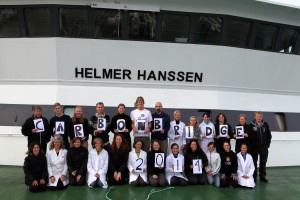 CarbonBridge completed it’s field season with a third cruise to the waters northwest of Spitsbergen. As in May, dense sea ice prohibited RV Helmer Hanssen from reaching CarbonBridge’s main study area northeast of the Svalbard Archipelago. Nevertheless, all 26 scientists om board were able to gather the samples and data they needed during three 24 hour long process stations and along three oceanographic transects. Now many hundreds to thousands of samples are waiting to be analysed.
CarbonBridge completed it’s field season with a third cruise to the waters northwest of Spitsbergen. As in May, dense sea ice prohibited RV Helmer Hanssen from reaching CarbonBridge’s main study area northeast of the Svalbard Archipelago. Nevertheless, all 26 scientists om board were able to gather the samples and data they needed during three 24 hour long process stations and along three oceanographic transects. Now many hundreds to thousands of samples are waiting to be analysed.
———————————————————————————————————
June 2014. Second CarbonBridge cruise successfully completed
CarbonBridge just returned from its’ second cruise to the waters around Svalbard. CarbonBridge aimed at studying physical and biological processes west and north of the Svalbard Archipelago. Dense sea ice prohibited however the research vessel RV Helmer Hanssen from reaching the northern flank, and CarbonBridge was bound to work off the northwest coast of Spitsbergen. Three oceanographic transects were run across the West Spitsbergen Current, transporting warm Atlantic water into the Arctic Ocean. Much effort was put into not only describing the physical properties of the Atlantic water, but also its chemical composition and the zooplankton community advected into the Arctic by this water mass. For this purpose, CarbonBridge used an laser optical plankton counter in combination with a CTD sonde mounted on a moving vessel profiler along all transects.
 In addition to the transect work, CarbonBridge conducted three process station in the marginal ice zone around the southern flank of the Yermark Plateau. At the process stations the pelagic community, from viruses to copepods, was studied in detail. Extensive experiments were run to investigate prevailing trophic structures and estimate primary and secondary production. At all three stations, an intensive phytoplankton bloom scenario was encountered, with chlorophyll concentrations of up to 25 µg/L.
In addition to the transect work, CarbonBridge conducted three process station in the marginal ice zone around the southern flank of the Yermark Plateau. At the process stations the pelagic community, from viruses to copepods, was studied in detail. Extensive experiments were run to investigate prevailing trophic structures and estimate primary and secondary production. At all three stations, an intensive phytoplankton bloom scenario was encountered, with chlorophyll concentrations of up to 25 µg/L.
———————————————————————————————————
May 2014. CarbonBridge celebrates the Norwegian national day in the ice
 CarbonBridge left Longyearbyen onboard RV Helmer Hanssen May 15 for its second cruise. For three week 27 scientists from seven nations will investigate the physicochemical and biological structure of the water masses west and north of the Svalbard Archipelago. Tons of equipment are with us on board to allow to investigate in detail all kinds of planktonic organisms, from viruses to mesozooplankton. On May 17 CarbonBridge celebrated the Norwegian national day in its traditional way by eating far too much ice cream, waving flags and singing some happy songs.
CarbonBridge left Longyearbyen onboard RV Helmer Hanssen May 15 for its second cruise. For three week 27 scientists from seven nations will investigate the physicochemical and biological structure of the water masses west and north of the Svalbard Archipelago. Tons of equipment are with us on board to allow to investigate in detail all kinds of planktonic organisms, from viruses to mesozooplankton. On May 17 CarbonBridge celebrated the Norwegian national day in its traditional way by eating far too much ice cream, waving flags and singing some happy songs.
———————————————————————————————————
March 2014. CarbonBridge’s sister project MicroPolar successfully completed it’s firts cruise
CarbonBridge’s sister project “MicroPolar” successfully completed it’s first cruise March 11, following the northern transect of the CarbonBridge cruise in January this year. The projects are tightly linked, and uses each others cruises to describe a complete seasonal cycle in plankton dynamics in the water masses north off Svalbard.
Learn more about the work of MicroPolar through the cruise blogg and facebook page.
———————————————————————————————————
January 2014. CarbonBridge completes its first cruise with great success
 CarbonBridge’s first cruise aimed at studying the physical and biochemical properties of Atlantic water flowing into the Arctic Ocean during winter. Two oceanographic transects west and north of the Svalbard Archipelago were sampled for water mass characteristics, such as temperature, salinity, nutrients, inorganic and organic carbon compounds, as well as zooplankton distribution and composition in the beginning of January 2014.
CarbonBridge’s first cruise aimed at studying the physical and biochemical properties of Atlantic water flowing into the Arctic Ocean during winter. Two oceanographic transects west and north of the Svalbard Archipelago were sampled for water mass characteristics, such as temperature, salinity, nutrients, inorganic and organic carbon compounds, as well as zooplankton distribution and composition in the beginning of January 2014.
In addition to the mapping of water masses, experiments on planktonic organisms, ranging from bacteria to large copepods, were conducted on board to investigate trophic interactions and metabolic processes of planktonic organisms during the darkest period of the year.
———————————————————————————————————
November 2013. CarbonBridge scientist conducting Arctic research in southern California
Camilla Svensen, a ”work-package”-leader on CarbonBridge and associate professor in zooplankton ecology at UiT – The Arctic University of Norway, has recently shifted address from the high North to southern California.
As a Fulbright Arctic Chair 2013/2014, Camilla will spend 7 months as a guest researcher at Scripps Institution of Oceanology (SIO) in San Diego. Fulbright is an organization aiming to facilitate scientific, educational and cultural exchange between the US and numerous other countries. The Arctic Chair Award is available for researchers working with Arctic issues.
During her stay at SIO, Camilla will collaborate with Dr. Maria Vernet on investigating production of dissolved organic carbon (DOC) from Oithona feeding on dinoflagellates. Oithona is a small cyclopoid copepod present in large abundances worldwide, but their role in the carbon cycle is not well defined. The methods developed at SIO will also be relevant for continued investigation of Oithona and other zooplankton species in Arctic ecosystems. Moreover, as part of the Fulbright project Camilla will give lectures and communicate arctic research at SIO and other US institutions. She is blogging about her scientific and cultural experiences at www.sciencenordic.com.
The project has previously received attention at www.forskning.no (in Norwegian):
http://www.forskning.no/artikler/2013/mai/357206
October 2013. Kick-off meeting of CarbonBridge’s sister project “MicroPolar”
 CarbonBridge was part of the initiation of the research project “MicroPolar [µP]: Processes and Players in Arctic Marine Pelagic Food Webs – Biogeochemistry, Environment and Climate Change” at the University of Bergen in the beginning of October 2013. MicroPolar focuses on the diversity and ecological significance of microbes in Arctic waters, and their influence on biogeochemical cycles. CarbonBridge and MicroPolar were both funded by the Norwegian Research Council in spring 2013 and will share much of their field work around Svalbard in 2014.
CarbonBridge was part of the initiation of the research project “MicroPolar [µP]: Processes and Players in Arctic Marine Pelagic Food Webs – Biogeochemistry, Environment and Climate Change” at the University of Bergen in the beginning of October 2013. MicroPolar focuses on the diversity and ecological significance of microbes in Arctic waters, and their influence on biogeochemical cycles. CarbonBridge and MicroPolar were both funded by the Norwegian Research Council in spring 2013 and will share much of their field work around Svalbard in 2014.
September 2013. CarbonBridge kick-off meeting
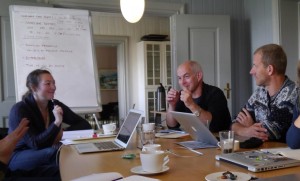 CarbonBridge was officially started at the historical site Skansen in Tromsø the last week of September 2013. CarbonBridge has a strong international component, and among the 25 meeting participants eight nations were presented. Following a presentation of the holistic idea and specific tasks of the project, the practical work started. We planned cooperation and communication around existing time series, utilization of different model types, and practical issues related to the upcoming fieldwork. We look forward to a project with great people, good science and lots of fun.
CarbonBridge was officially started at the historical site Skansen in Tromsø the last week of September 2013. CarbonBridge has a strong international component, and among the 25 meeting participants eight nations were presented. Following a presentation of the holistic idea and specific tasks of the project, the practical work started. We planned cooperation and communication around existing time series, utilization of different model types, and practical issues related to the upcoming fieldwork. We look forward to a project with great people, good science and lots of fun.
August 2013. CarbonBridge has gotten a logo
 The project has gotten its logo! The project’s name “CarbonBridge” is a metaphore for the carbon and other nutrients transported into the Arctic Ocean with Atlantic water masses. Quantifying this transport is one of the goals of CarbonBridge. The arrow in the project’s logo stands therefore for the inflow of Atlantic water into the Arctic, depicted by the ice flow entering the logo from the right.
The project has gotten its logo! The project’s name “CarbonBridge” is a metaphore for the carbon and other nutrients transported into the Arctic Ocean with Atlantic water masses. Quantifying this transport is one of the goals of CarbonBridge. The arrow in the project’s logo stands therefore for the inflow of Atlantic water into the Arctic, depicted by the ice flow entering the logo from the right.





